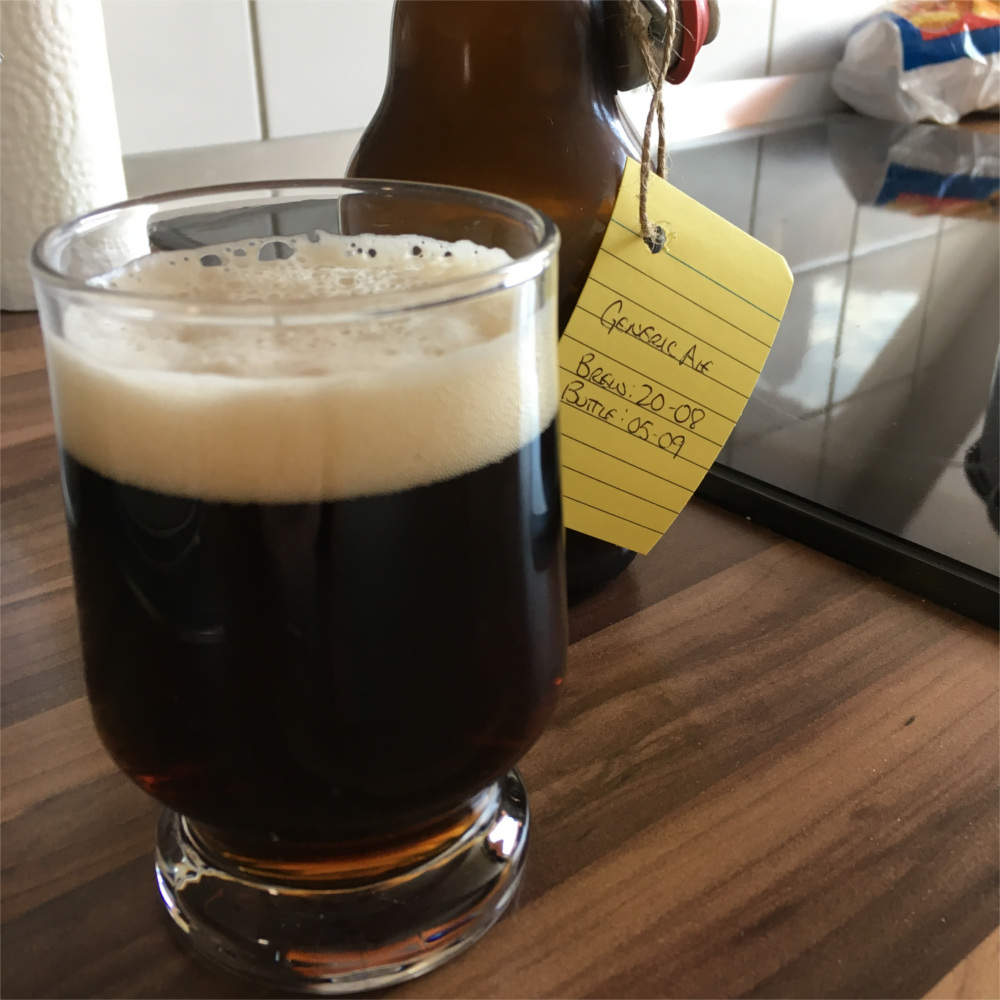A Generic Ale
Brewing at home is definitely not economical. No homebrewer saves money by making beer rather than simply making the trip to the store. However, the freedom one has when designing a recipe to target a specific flavor or to produce a favorite style will always make for an enjoyable brew day.
Having purchased all new equipment for my new abode in Erfurt, I set out to test it all out with a generic beer. To complicate things, I have grain and yeast, but no hops. Luckily, I know of a brewery where I not only can mill my grain, but also beg for hops. And as it was simply a first go, I beseeched for old, unwanted hops; there was no label, so I was unsure what to expect from the final product.
| Grain | Amount |
|---|---|
| Pale Ale | 1 lbs |
| Abbey Malt | 0.2 lbs |
| Carafa | 0.05 lbs |
| CaraBelge | 0.2 lbs |
The hop schedule is quite simple: add approximately eight ounces of the unknown hop at 60 minutes (right when the boil is first achieved), and the other eight ounces when 10 minutes remain (i.e., after 50 minutes from the first addition).
The options for brewing supplies are either sparse in Germany, or I am really bad at playing with Google Deutschland. So, the most legit beer yeast I have found here is a brand called, “Zymoferm”, and the yeast I will be using is called “Best West USA.”
I do believe in using a mash schedule rather than simply trusting that the malters have provided me quality malted grains. In the unlikely situation that my malt is a bit subpar, this process should smooth over some of the faults that may exist in my grains. Typically, full grain brewers will maintain a temperature of 158°F to 160°F and hit both the alpha and beta amylase ranges in one go. I like complexity.
| Target | Actual | Volume | Notes |
|---|---|---|---|
| Dough In – 15 min @ Cool Tap Water | 68°F | 1.5L (w/ Grain 2L) | Started at 14:30 |
| Protein Rest – 30 min @ 122°F | 122°F | 3L | Added Boiling Water at 16:00 (Maternal Unit called) |
| Beta Amylase – 45 min @ 154°F | 153°F | 4L | Lasted 50 mins; heated for 10 mins to Alpha |
| Alpha Amylase – 15 min @ 164°F | 164°F | 4L | Lasted 15 mins; heated for 10 mins to Mash Out |
| Mash Out – 10 min @ 170°F | 170°F | 4L | Lasted 10 mins |
After sparging the grain from the wort (a.k.a., the liquid produced from the mash), I add some boiled water to increase the boil volume as well as speed up the time to reach my boil. I achieve a rolling boil at 17:52 and follow my hop schedule.
I am quite surprised to see my volume drop from 4.25L to 2.75L in just one hour of boiling. I may want to lower the temp of my rolling boil for future brew days. Once my hour long boil is complete, I place my entire stockpot in my freezer for about four hours. This will drop the temperature of the wort to that in which the yeast will thrive; too hot and they will simply die, too low and it will delay their activity. Having prepped my fermentation vessel (a 5L carboy), I pour the cooled wort in as well as some additional pre-boiled and cooled water to get my desired volume. I do not yet own a hydrometer; this would be a good point to measure my potential alcohol level.
I pitch the yeast, take a picture and hit the sack at 22:15.
Two weeks later, I prepare the bottles. Again, I am having trouble finding the typical corn sugar for carbonating, so I opt for normal cane sugar. I am adding 0.7 ounces for the approximately 1 gallon of beer that I am bottling. Again, I boil the sugar water and then cool it before mixing it with the flat alcohol solution. After that, I make a mess in my kitchen attempting to fill bottles on my own. Spilling wort makes a sticky, sugary mess; spilling fermented beer makes your kitchen smell like a frat house.
After another two weeks, the beer is carbonated. I crack one open to inspect the results. This ale is darker than necessary. My first sip tells me that it is a bit too young – it bites back. It is arguably quaffable, but could probably benefit from another week of mellowing out. I am excited to see the head that it holds; my guess is that the CaraBelge pulled that off for me.
Prost!











